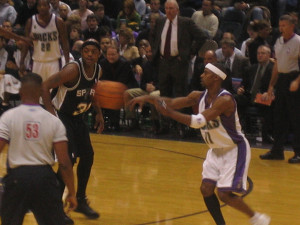Pass Fake: A Key to Unlock Defences
The Pass Fake is one of the fundamental technical skills taught to basketball players at a very young age. Usually put into the bag of trick players are given around the age of ten or eleven years of age. There are a number of different reasons why the skills is taught at this age but unfortunately with such a young audience the benefits of the skill is often undersold and poorly taught.
A pass fake comes to the forefront of offensive tactics when a player is facing a zone defence. Offensive players trying to break down a zone defence often become over anxious and play the sport of basketball at too high a tempo. This results in the true high percentage scoring opportunities presented by a team’s zone offense often being missed and lower percentage poorer alternatives being taken. A pass fake utilised in these situations provides a buffer for players when they have the ball in their hands. By performing a pass fake, the offensive players automatically hold onto the ball for a few seconds longer, slowing the offense and potentially seeing more of the opportunities presented in front of them.

The other advantage in making a conscious effort to utilise the pass fake in a team’s zone offense is that the skill often triggers defensive player movement. Defensive players are taught often by their coaches (if aware) to move on the flight of the ball, for players however this often translates into cutting corners and moving as the passing technique is initiated. This anticipation by defensive players can result in deflections and steals, but in many situations it results in the structure of a zone defence becoming broken and the seams exposed (making the right choice is often called defensive awareness). A pass fake can be used to trigger this over reactive anticipation in a defensive player. While the movement might not be enough to expose a driving lane to the basket, it might be enough to create a passing lane to an interior target from the perimeter.
When looking to implement the skill of a pass fake into a team’s zone offense ensure this transitions from being a token point of note to a good habit by focusing on the activity constantly. In each drill and scenario ask player to use the skill constantly to ensure for each individual it becomes a good habit of their play against a zone defence.
The pass fake can be just as effective when used against man-to-man defences. For the same reason of an over reactive defensive player, the ability to shift defenders and expose possible opportunities is always a valuable outcome from using a pass fake. The interesting point of note here is the more intense the defensive pressure being applied to the offensive team, the more effective techniques like a pass fake or shot fake become. As a coach highlighting the use of these techniques in situations of high defensive pressure will again force player to hold the ball for longer and hopefully make a less rash choice and when in the half court expose possible prospects to create offense.
A pass fake is a very effective tool for helping individuals create scoring opportunities for themselves and those around them. Where a shot fake often triggers the defence to collapse of the offensive player, a pass fake often results in movement away from the player with the ball. This helps reduce pressure and increase confidence of a player to make a better choice from a wider selection of possible options.






